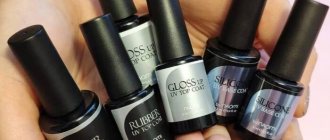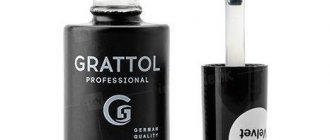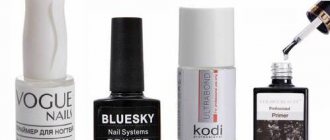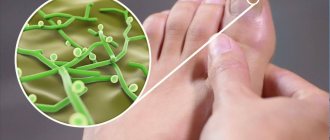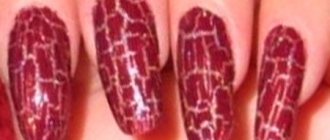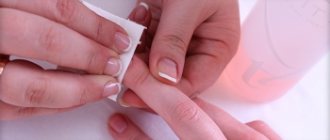- August 7, 2018
- Nail care
- Chernaya Natalya
A manicure scraper is a special tool used by professional manicurists. It is often used in self-care for nails at home.
Tool Features
A special feature of the tool is that it has two working surfaces. Each of them has a special shape, and therefore they perform different functions. One of the surfaces is shaped like a small spatula. It is used to treat the cuticle, removing its thin layer that grows directly to the skin that is located around the nail plate.
The other side of the scraper may have a regular handle or a different tip. The appearance of a double-sided manicure scraper depends on the functional features of this side. Basically, the second end is used to clean the edge of the nails from dust and various contaminants. It has special notches for this purpose. A tool with 2 tips is used to treat sensitive skin, as it causes almost no injury to the cuticle and dermis located around the nail.
Device and characteristics
In its simplest form, a scraper is a hand tool, which is a metal rod, on one side of which there is a handle for easy holding and safe operation, and on the opposite side there is a cutting part with a certain sharpening angle.
The end faces, if we talk about a flat tool, are its cutting edges.
In addition to one-piece versions, there are also composite models with a holder equipped with a clamping screw for fixing replaceable cutting inserts.
This design is designed for the use of attachments of various shapes, which allows you to solve a wide range of problems with one tool.
In industry, along with hand tools, the following are most often used:
Pneumatic scraper (pneumatic scraper) - in a small body there is an impact mechanism with a piston, which transmits translational movements of a certain frequency to a removable attachment - a chisel. The tool is powered by compressed air, and therefore a compressor pneumatic hose is connected to its back. On average, the operating frequency reaches 2.2 - 4.5 thousand vibrations per minute, air flow is about 100 - 115 l/min.
An electric scraper (electric scraper) is a tool with a built-in electric motor, powered by a battery or mains. Can be used as an electric chisel or chisel. The average power consumption, depending on the model, is 150 – 350 W.
Among the classic scrapers, there are double-sided versions, where the working elements are located on both sides of the handle.
Also, for processing wide surfaces, a disk tool is used, where a sharpened carbide disk acts as the working part.
Material
The shaft of a hand tool is usually made of tool steel.
The working part is a carbide cutting element.
The material for the handle is plastic or wood.
Composite scrapers are equipped with replaceable plates, the raw materials for which are often alloys with high hardness values (64 - 70 HRC).
To work with soft materials and plastics, ceramic versions of the tool are used, equipped with a one-, two-, or even three-component handle.
As for pneumatic models, their body is made of lightweight but durable materials that can withstand high loads, such as aluminum alloys.
Electric versions usually have a plastic housing, rubberized where it is held by hand.
Dimensions and weight
The dimensions of a hand scraper depend on its purpose and the configuration of the cutting part, as a rule, they are within the following limits:
- Length: 190 – 550 mm.
- Width of the working part (depending on the scraping method): 5 – 75 mm
- End thickness: 2 – 4 mm.
For disk versions, the disk diameter is on average 50 - 60 mm with a thickness of 3 - 4 mm.
Hand scrapers weigh about 100 – 600 g.
The dimensions of pneumatic and electric options correspond to the characteristics of medium-sized drills.
Work surface shape
Manicure scrapers and pushers, depending on the working surface, are:
- round;
- square;
- semicircular;
- oval;
- flat.
There are pushers for pedicures. They have a wider working side, which is very convenient for caring for the cuticles on the legs, which are more rigid. Therefore, the tool is distinguished by its rigidity and greater thickness.
Types of tools for scraping
Today, specialists use various types of scrapers, differing from each other in several parameters. One of these parameters is the shape of the cutting part of the tool, depending on which scrapers are divided into flat, triangular and shaped. Unlike flat and triangular type tools, shaped scrapers have a working part that completely follows the shape of the surface of the workpiece.
Scrapers with various working parts
Triangular scraper with wooden handle
A tool, the working part of which has several edges, mainly processes cylindrical and concave surfaces, and flat scrapers successfully cope with the processing of various grooves and grooves. In practice, disc and ring-shaped scrapers are often used. With the help of the former, parts with wide surfaces are processed, and the latter are used for scraping products that have a round shape.
According to their design, scrapers can be one-piece or dismountable, single- or double-sided. More durable are double-sided scrapers, which differ from single-sided scrapers in that they have two working parts located on both sides of the handle.
Composite scraper device
The working part of the scraping tool, according to its location relative to the handle, can be flat or curved. Scrapers, the working part of which has a curved shape, are most conveniently used for processing soft metals, as well as parts with sharp corners.
Relatively recently, only hand scrapers were used in plumbing, but today many manufacturers offer tools equipped with a pneumatic or electric drive. You still have to manipulate such a tool manually, but this requires much less effort than when using a hand scraper.
Universal scraper BIAX
Material of manufacture
Various materials are used to make such instruments. The highest quality manicure scraper is made of stainless steel, which is used for the manufacture of medical instruments. Pushers can be:
- silicone;
- plastic;
- wooden;
- metal.
Plastic tools may have a rubber or silicone tip at the end. It is very convenient and safe, especially when treating very thin cuticles and sensitive dermis. A correctly selected scraper fits comfortably in your hand and does not slip. For this purpose, steel models have notches.
Types of scrapers and their prices
There are two types of this tool according to the scope of application:
- A metalwork scraper is used when working with metal products, repairing components and assemblies, and cleaning their surfaces from residual sealant and gaskets.
- Construction - used in construction and repair for treating hard-to-reach places, large surfaces, removing paint, old plaster, putty and other materials, scraping dried adhesive from tiles.
The last type is an electric scraper.
Electroscraper
A tool with a body shaped like a cylinder, inside of which an electric motor is hidden.
The working part consists of a holder that moves back and forth at high speed, in which a nozzle of a certain configuration is fixed, depending on the tasks.
Pneumatic scraper
A pneumatic scraper is an analogue of the previous version, the mechanism of which is driven by compressed air.
A scraper for metalworking purposes, in turn, can be classified according to the type of drive:
Manual
A classic version that looks like a chisel.
It has a handle for holding, a base in the form of a steel rod, at the end of which there is a direct working part.
Its average cost is 600 – 1200 rubles.
Mechanical (mechanized)
Designed to speed up and simplify the work, since scraping is a rather labor-intensive and time-consuming process.
This includes electric scrapers, powered by the network, as well as pneumatic models, whose operating principle is similar to a jackhammer, through which fairly deep scraping can be achieved in one pass.
Their price can reach 40 thousand rubles, on average it is from 7 thousand rubles.
Since manual models remain the most common, their design is constantly modified by manufacturers to perform specific tasks, their functionality is expanded, and therefore on the tool market you can find:
Unilateral
Models where the working part is located only on one side of the base rod.
Double sided
They have two working parts of the same or different configurations, located on both sides of the handle.
Both of the above options can be solid (monolithic construction) or with inserted cutting inserts.
Universal
Here the working part of the scraper is equipped with a holder with a fixing screw or other clamp into which different cutting blades are inserted.
Thus, a universal or composite scraper is obtained, which is used to solve a wide range of problems by installing a plate of the required configuration.
The average cost is about 1000 – 1500 rubles.
According to the shape of the working part there are:
- Flat models - used for working with flat surfaces, open grooves and grooves.
- Triangular versions, as well as tetrahedral models, are mainly used for processing cylindrical and concave surfaces.
- Shaped - have a cutting edge that follows the shape of the surface being processed.
There are also semicircular, hook-shaped, spoon-shaped and other types of scrapers designed to perform strictly defined jobs.
In addition to the standard tool, less common variations are also actively used in practice:
- Disc scrapers – for processing wide surfaces.
- Ring – for working with round-shaped products.
Intrinsically safe
These are specialized models; the working part of such scrapers is made from special materials, for example, bronze alloys, copper, beryllium, etc.
Intrinsically safe scrapers are also non-magnetic due to the properties of the materials from which they are made.
Attention!
An explosion-proof tool must be certified.
The cost of specialized scrapers exceeds 12 thousand rubles.
Depending on how the working part of triangular, shaped and other scrapers is located relative to the handle, they are divided into straight and curved (curved).
The latter are convenient when working with soft materials, as well as elements with sharp corners.
Precise scraping of small metal parts requires specialized, suitable tools.
Jewelry (pawnshop)
Numismatists use miniature conical scrapers with a hardness of 50–60 units and a total length of about 115 mm when working with jewelry, and jewelers use miniature conical scrapers when working with jewelry, which is comparable to an ordinary ballpoint pen.
The cost of this jewelry instrument is about 250 rubles.
The manufacturing material is often various hard alloys.
The tool is suitable for restoring small finds of value; it is usually sold in sets of 4–5 units.
When processing soft materials, including plastics, a ceramic scraper is preferred.
It perfectly removes thin layers from flat surfaces and edges of products, and also effectively removes burrs.
Only the cutting part is made of ceramics, which is not subject to corrosion and does not require long sharpening times.
The cost of such a tool can reach up to 2 thousand rubles, depending on the manufacturer and the configuration of the cutting edge.
There are also special scrapers for removing burrs from the edges and corners of the workpiece.
Typically, such scrapers are sold in sets with attachments with different angles of inclination and curvature.
The cost of such sets starts from one thousand rubles.
Manicure
A tool that differs not only in purpose, but also in design.
It is used in cosmetology and is called a pusher; it is a metal rod with a blade having a tapering flat tip, which is used to pry the edge of the pterygium and move it to the base.
This procedure allows you to carefully and evenly cut the skin at the base of the nail using tweezers.
Classification by functionality
All pushers are classified depending on functionality. There are single-sided tools (they are the simplest) and double-sided ones. The scraper, which has a curved blade configuration, is very convenient and does not slip during operation. Pushers are produced with a tip in the form of a large spatula and lance. They are used for manicure and pedicure.
One of the most common is a manicure scraper in the form of a hatchet. One of its sides is presented in the form of a spatula, with the help of which unedged and trimmed manicures are performed, and on the other - a hatchet. They use it to clean the surface of the nail from pterygium and various coatings that could not be removed with special means. You can also clean out any dirt that has accumulated around the edges of your nails.
There is a scraper specifically designed for working with ingrown toenails. The tip is a spatula or knife. You can easily treat such nails.
There are varieties that eliminate calluses and also help prepare the surface of the nails for gel or acrylic extensions. These tools must be used extremely carefully and require special skills.
A separate type of pusher is a magnetic paddle. This special tool is used to make patterns on magnetic varnish. The result is an amazing manicure.
Areas of application for scrapers
Using a scraper, a specialist removes the thinnest layer of metal from the workpiece, the thickness of which can vary between 0.005–0.7 mm, which allows the degree of surface roughness to be brought to the required level. With the help of such a technological operation, parts are often processed that will subsequently mate and move relative to each other. The most common parts for finishing which various types of scrapers are used are:
- parts of machine tools and high-precision instruments;
- elements of sliding bearings;
- various measuring instruments and devices for carrying out control operations;
- blades of cutting tools (to sharpen them, a so-called sharpener-scraper is used).
Scraping - finishing the lathe slide guides
One of the advantages of scrapers is their versatility, so their scope of application is not limited to the above points. Using such tools, they perform engraving work on the surface of soft materials, process the edges of parts, and remove old coating. They have also found application in cosmetology; manicurists use them to perform their manipulations.
The scrapers used to solve various problems can be distinguished from each other even by photos, since they have different designs and geometric parameters. Thus, a miniature manicure tool is made in the form of a spatula with a comfortable handle, and devices for scraping large workpieces can be produced in the form of carbide plates. It is quite difficult for a non-specialist to guess that such a plate is a scraper, even if he sees it in person and not in a photo. To use this tool, you need a special lock, equipped with a comfortable handle for performing metalwork manipulations.
The scraping technology depends both on the size and configuration of the workpiece, and on the hardness of the material from which it is made. A specialist who is going to perform such a technological operation must correctly select the sharpening angle of the working end part of the scraper relative to its axis. When processing different materials, this angle must be within the following limits:
- when scraping soft metals – 35–400;
- when processing the surfaces of steel parts – 75–900;
- when performing scraping of parts made of cast iron and bronze - more than 900.
How to use
Many people have a question: how to use a scraper for manicure? This tool is a must if you want to get a good manicure. The fact is that when they move the cuticle, the varnish lies on the surface of the nail much more evenly, and the nail visually lengthens.
However, you need to take into account some nuances. The first concerns steaming your fingers in warm water, to which you can add a decoction of herbs or drop any essential oil. The main thing is that the cuticle is steamed and can be easily pushed back.
Then be sure to wipe your hands and areas to be treated with oil specifically designed for the cuticle. It will make the skin softer. The dermis that surrounds the nail plate will become more tender in the future.
After this, use a pusher to gently (on each finger separately) move the cuticle. This type of work needs to be done with the flat end. If the dermis does not want to come off, you need to remove the adherent cuticle with careful cleaning movements of the scraper.
This tool will not be able to cope with burrs and keratinized tissue. They are removed using nail scissors or tweezers. You need to cut it carefully, right next to the nail.
When working with cuticles, it is necessary to maintain an inclination angle of 45 degrees. There is no need to lift it parallel to the nail and you cannot press it from top to bottom.
We must remember to sterilize the instrument, even if it is for personal use. You can process it:
- antiseptics;
- boiling;
- ultraviolet lamp.
A manicure scraper made of plastic or wood cannot be boiled. It is necessary to wipe it with an alcohol solution.
How to choose manicure tools
Manicure is not only a gel coating, but also a preliminary treatment of the nail plate. We have already discussed how to properly care for the cuticle and what types of manicure there are. Now let's talk about the tools that will be useful to you for this, using our new brand SAY as an example.
For classic edged and combined manicures, it is customary to use three main types of tools. These are nippers, scissors and pushers (scrapers). Let's look at each of them in more detail.
Scissors
Let's start with the most, at first glance, simple and familiar manicure tool - scissors. Unlike nippers and pushers, almost everyone uses scissors. But have you paid attention to the shape and roundness of the blades? Their main function depends on this.
Nail scissors have wider and longer blades. If you have a soft nail plate, then it is better to choose models with curved ends, and for harder nails, classic straight blades are suitable. There are also children's models, they differ from adults in the safe rounded ends of the blades, which cannot be cut.
Blades designed for cutting cuticles are thinner and more accurate, making them excellent at cutting delicate and soft tissue. SAY cuticle scissors have a smooth stroke, and as a result the cut is smooth and neat, without microtraumas or snags.
Wire cutters
Nippers or, as they are also called, tongs are an alternative to scissors. They are much stronger and larger, and therefore cope even with rough nails and overgrown and keratinized cuticles. The quality of the manicure depends on the alloy, convenience and sharpening of the tool, so you need to be extremely careful when choosing.
The steel from which SAY wire cutters are made is ultra-strong, corrosion-resistant and will easily withstand any type of sterilization. Thanks to its convenient shape, hand sharpening and three-stage quality control, this tool will definitely serve you for a long time.
Nippers are divided into three types: for nails, for cuticles and for pedicure.
- For nails
Why cut the length of your nail with clippers if you have scissors? It's simple: when using this device, the risk of injuring or splitting the nail plate is significantly reduced. Moreover, they cut the nail quickly and accurately, which is not always possible to do with scissors.
- For cuticle
It is best to trim hard, overgrown cuticles so that they do not spoil the appearance or become a source of hangnails. Cuticle scissors are suitable for soft and elastic skin, but will not cope with more advanced and complex cases.
- For pedicure
The largest clippers are designed for pedicures and working with fairly thick and rough nails. They are distinguished by a long blade - up to 2 cm - and easily remove the length of the nail. And since one of the most common problems in pedicures is ingrown toenails, these tongs will cope with this task as well.
Pusher and scraper
Tools designed to work directly with the cuticle are often confused. So is it a pusher or a scraper? And what are these strange names?
A pusher (from the English push - “push”) is a special spatula that is used to push back the softened cuticle. Instead of a pusher, an orange stick is sometimes used, but it may not cope with hard or overgrown skin.
A scraper (from German schaben - “scrape”) is a tool for scraping. This term is more often used in construction, but is also familiar to experienced manicurists. A distinctive feature of the scraper is its hatchet-shaped knife, which allows you to trim overgrown cuticles, burrs and scrape off dirt from the plate without the risk of injury. Therefore, modern models are suitable even for beginners.
So, a pusher is a spatula, and a scraper is a beveled blade. Initially, these were two separate tools, but recently 2-in-1 models are increasingly being produced, with a scraper on one side and a pusher on the other. In this case, both name options will be correct, and the right of choice remains with the manufacturer.
SAY scrapers are made of high-alloy, that is, Japanese steel improved in composition, which is hardened using specially developed methods. All processing of the blades is done manually, which increases the service life of the tool.
How to choose
The safety and accuracy of your manicure directly depends on how correctly the tool is chosen. When purchasing a scraper or pusher, pay attention to:
- The quality of steel - the service life of the device depends on it
- The shape of the scapula - it should correspond to the shape of the nail plate
- Functionality of use - how versatile a tool do you want to use, classic or double-sided?
- Manufacturer - professionals recommend reading reviews about the brand before purchasing
- Convenience
And for nippers and scissors, important parameters, in addition to convenience, quality of steel and manufacturer, are also smoothness of operation - how easily the handles of the tool can be moved apart, the length of the cutting edge - be guided by the width of the nails and the size of the cuticle, and sharpening - it is better if it is done by hand.
How to care
Without proper care, new tools will soon become unusable. To prevent this from happening, you must follow a few simple rules.
Rule 1. Always place the tool with the blade up, do not drop it on the floor and store it in special attachments and cases.
Rule 2. Keep an eye on your blades and have them sharpened on time. A dull tool will do more harm than good to your nails.
Rule 3. Be sure to disinfect your tools after each use to avoid introducing bacteria. This can be done using special solutions or sterilizers.
Rule 4. And lastly, use all tools strictly for their intended purpose. Do not cut cuticles with nail scissors and vice versa.
Leading nail service specialists took part in the development of SAY brand products. Scrapers, nippers and scissors made using Japanese technology will serve you for a long time and will become reliable assistants in manicure of any complexity.
Popular brands
Popular brands include Stark pushers, which are manufactured using high-quality medical steel. They have a comfortable and non-slip handle.
Yoko scrapers from a well-known manufacturer are presented in glossy and matte versions. They vary depending on the length and functions performed.
A very common model is the Lazeti-222 model, which is a double-sided scraper with a hatchet and a semicircular concave blade at the ends. The latter is made carefully, its shape is symmetrical. The inner side is perfectly polished, the top is thinned, so it is easy to move the cuticle. In this case, the nail does not get scratched.
A characteristic feature of Zinger scraper models is the combination of two tips. One is a spatula, the other end is thin, sharp and cone-shaped and is intended for cleaning the dermis on the sides of the nail.
To keep your nails neat, you need to take care of them and the skin around them. In this case, it is impossible to do without a manicure scraper, which helps to model the nail hole. To do this, you need to try to choose a good and high-quality tool, and also learn how to use it correctly. Manufacturers of cosmetic and manicure products offer a lot of options, so every woman can choose the right model for her needs.
Purpose and principle of operation of the scraper
A scraper is a metal-cutting tool designed for scraping metal products.
This process makes it possible to achieve a minimum degree of surface roughness of parts and give them precise geometric parameters.
Using the tool in question, uneven surfaces are scraped off, resulting in a leveled surface, giving it maximum smoothness.
Depending on the type of operations performed, a classic flat scraper can be used:
- For rough processing of products, through which risks and traces of previous manipulations are removed. In this case, a tool is used with a sharpening angle of the cutting part of 70 - 75° with a width of 20 - 30 mm, which allows you to remove a layer of 0.02 - 0.07 mm.
- For semi-finishing, a tool with a width of 12-15 mm is suitable for removing 0.01 - 0.02 mm of microrelief in one pass.
- The cutting edge of models for finishing is made at an angle of 90° with a width of 5 – 10 mm. A tool with a pointed angle of 90 – 100° is used. For each pass, very thin layers (8 - 10 microns) of metal are removed.
In essence, a scraper is a tool for finishing metal products, through which microburrs are removed, the surface is leveled, work hardening is removed, and the geometry of the workpiece is precisely adjusted by removing a thin top layer of material.
You can scrape both flat and curved (including concave) surfaces and edges.
The principle of final processing with a scraper is to scrape off a layer of material similar to working with a chisel, while allowing movements of the tool both “from yourself” and “towards you”. The latter method is considered preferable due to higher productivity.
In addition to purely technical use, there is also a finishing use for the scraper.
In this case, the tool is used to create a design or pattern on metal.
NOTE:
When decorative scraping (inducing frost) the surface accuracy does not increase.
Scrapers are also used by auto mechanics to remove cotter pins, old gaskets, radiator hoses, and adjust parts to the required dimensions.




